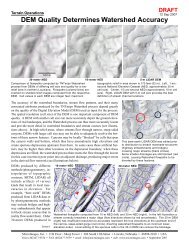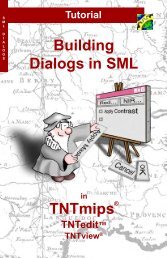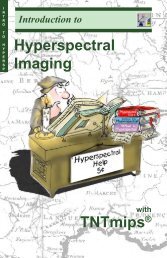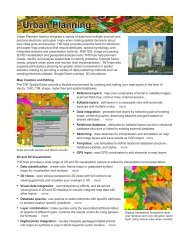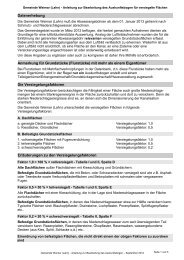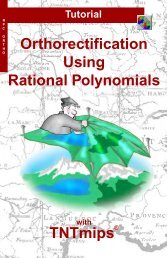Release Notes MicroImages, Inc. TNT-Products V. 6.8
Release Notes MicroImages, Inc. TNT-Products V. 6.8
Release Notes MicroImages, Inc. TNT-Products V. 6.8
Create successful ePaper yourself
Turn your PDF publications into a flip-book with our unique Google optimized e-Paper software.
Tablet PCs.<br />
RELEASE OF RV<strong>6.8</strong> <strong>TNT</strong> PRODUCTS<br />
The use of these new Windows XP supported systems is discussed in detail above. For<br />
a thorough and up to date review of what is available in the first generation Tablet PCs<br />
see www.pcmag.com/article2/0,4149,925249,00.asps for:<br />
Tablet PCs: R eady for Prime Time. by Cade Metz. PC Magazine. April 8, 2003. pp.<br />
100-112.<br />
Graphics<br />
Cards.<br />
Graphics chip and associated board developments continue at a rapid pace compared<br />
to all other workstation components, and these rapid improvements have a direct impact<br />
in geospatial analysis. <strong>TNT</strong>sim3D makes direct use of these advances by using their<br />
hardware implementation of DirectX and OpenGL. <strong>MicroImages</strong> X server for Windows<br />
now directly<br />
supplies built-in support for OpenGL [see section MI/X Server below], how-<br />
ever, use of this and/or DirectX will only gradually be implemented<br />
in existing <strong>TNT</strong> processes,<br />
for example, the rendering of 3D displays.<br />
Current<br />
Leader.<br />
At the moment, the lead in the graphics cards goes to the ATI’s Radeon 9800 Pro over<br />
nVIDIA’s BFG Asylum GeForce FX 5800 Ultra. As seems to be a very standard continuing<br />
practice, both of these boards are being introduced at the US$400 price point.<br />
The nVIDIA board is not shipping as of yet. For comparison tests please see<br />
www.pcmag.com/article2/ 0,4149,980836,00.asp for<br />
ATI Maintains a Rad Lead. PC Magazine. by Konstantinos Karagiannis, 22 April 2003.<br />
p. 38<br />
Some interesting points made in this comparison are:<br />
“Both cards feature support for DirectX 9 [9 is already tested with <strong>TNT</strong>sim3D] and<br />
OpenGL, as well as 8X AGP.”<br />
“These differences give the 9800 Pro a memory bandwidth<br />
of 21.8 GBps compared with<br />
only 16 GBps in the<br />
5800 Ultra”.<br />
“Indeed, our tests showed—at worst—only a tolerable performance drop when 4X antialiasing<br />
was activated [for the ATI 9800].” [Anti-aliasing is important in improving the<br />
appearance of <strong>TNT</strong>sim3D and 3D game operations. Activating it caused a frame rate<br />
decease before this chip. ]<br />
“The new GeForce FX architecture comes in a new form factor. We are not thrilled<br />
with<br />
the card’s thickness—it eats up two card slots because its fan assembly – nor with its<br />
huge power draw (you’ll need at least a 300-watt power supply). And when the fan kicks<br />
in, it’s loud.” [Another reviewer pointed out that the FX consumes 180 watts and if it<br />
were positioned just inside the top of the PC, it could be used as a coffee warmer as<br />
well. Certainly this is an impractical power draw.]<br />
Future<br />
Orientation.<br />
Can graphics chips continue their advance? Some insight can be gained from an excerpt<br />
from an article reviewing ATI’s lead and where graphics chip design is headed.<br />
The startup that saved ATI. Armed with management and engineering prowess for<br />
ArtX, No. 2 player in 3-D graphics is positioned for the next round of pixel wars. Electronic<br />
Engineering Times. Issue 1266. Rick Merritt. 21 April 2003. pp. 18-20.<br />
MICROIMAGES MEMO 24<br />
5 MAY 2003



